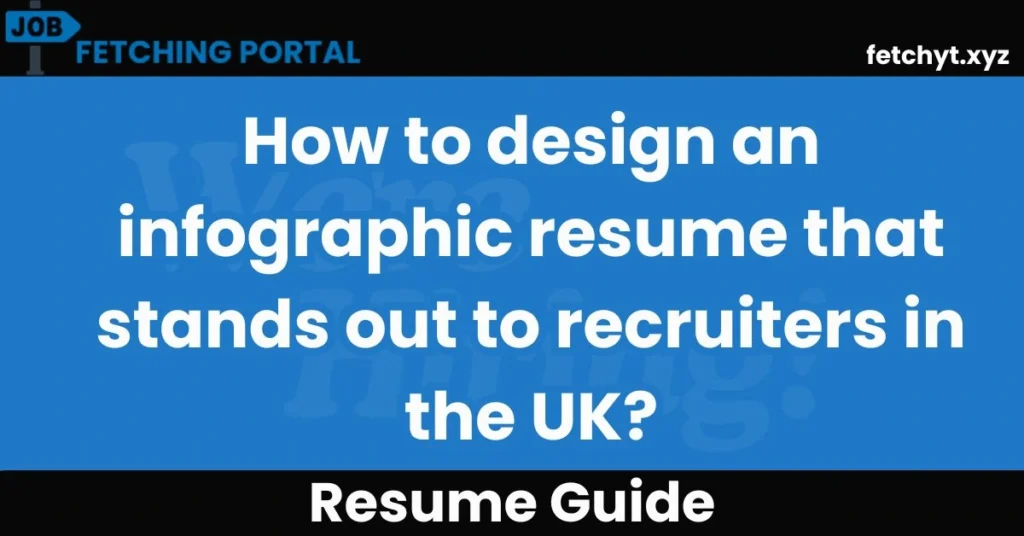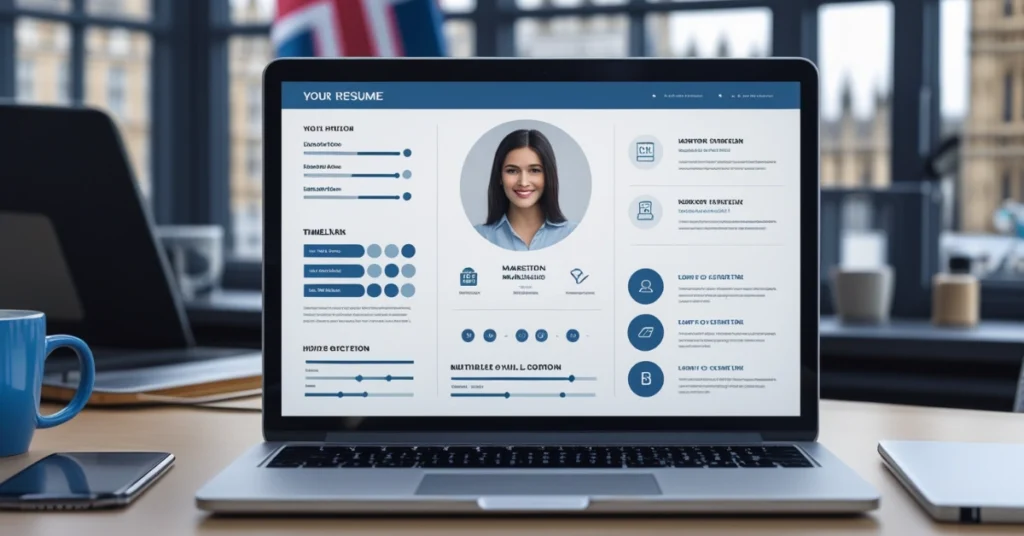Learn how to design an infographic resume that stands out to recruiters in the UK. Discover expert tips, best tools, and winning strategies to impress employers fast!
In the highly competitive UK job market, grabbing a recruiter’s attention within the first 6 seconds is crucial. That’s where an infographic resume becomes a game-changer. If you’re wondering how to design an infographic resume that stands out to recruiters in the UK, you’re in the right place.
This guide walks you through every step, from choosing the right layout to optimizing for Applicant Tracking Systems (ATS), so your resume not only gets seen but remembered.

Also Read About : Institute of Regional Studies Islamabad Jobs 2025
What is an Infographic Resume?
An infographic resume is a visually engaging alternative to the traditional text-heavy CV. It uses graphics, icons, timelines, charts, and minimal text to present your professional background, skills, and achievements in a clear, appealing format.
Infographic resumes are particularly useful for creative roles like:
- Graphic Design
- Marketing & Advertising
- UX/UI Design
- Content Creation
- Public Relations
But when used strategically, they can benefit professionals across various industries—especially when applying to startups or modern firms with design-forward cultures.
Why Infographic Resumes Are Gaining Popularity in the UK
Recruiters in the UK face hundreds of CVs daily. An infographic resume can:
- Capture attention quickly
- Highlight key information fast
- Reflect creativity and soft skills
- Make your achievements more memorable
- Show data visualization skills (for data/analytics roles)
According to a recent LinkedIn UK survey, 78% of hiring managers said they are more likely to remember a visually distinctive resume. That’s powerful.
When to Use an Infographic Resume (and When Not To)
While infographic resumes can be incredibly impactful, they’re not always the right choice.
| Use Infographic Resume If | Avoid If |
|---|---|
| Applying for creative or modern roles | Applying through strict online portals |
| Sending your resume directly to a person (email/LinkedIn) | Submitting via ATS systems (which may not parse it) |
| Adding a resume to an online portfolio or personal website | Applying to highly traditional or formal industries |
Pro Tip: If in doubt, send both a traditional and infographic version.

How to Design an Infographic Resume That Stands Out to Recruiters in the UK
Let’s break this into practical, easy-to-follow steps:
1. Define Your Objective and Audience
Before opening any design tool, ask yourself:
- Who is your target employer?
- What are their values and aesthetics?
- Are they traditional or modern?
Understanding your audience ensures your design aligns with the company culture and expectations.
2. Choose the Right Resume Format
There are different types of infographic resume layouts:
- Timeline-based (great for showcasing career growth)
- Skill-based (ideal for highlighting competencies)
- Hybrid (mix of text and visuals)
Pro Tip: Use a clean layout with plenty of white space to keep it readable.
3. Select the Right Tools
Here are some powerful tools to help you create stunning infographic resumes:
| Tool | Best For | Pricing |
|---|---|---|
| Canva | Beginner-friendly, templates | Free / Premium |
| Adobe Illustrator | Custom, professional design | Paid |
| Venngage | Data visualization features | Free / Paid |
| Piktochart | Visual storytelling, charts & timelines | Free / Premium |
| Visme | Interactive and animated resumes | Free / Paid |
Canva is often the go-to for UK job seekers due to its ease of use and UK-relevant templates.
4. Include Only Key Information
Less is more. Include:
- Contact info (email, phone, LinkedIn)
- Career summary
- Work experience
- Education
- Skills (soft + hard)
- Achievements or metrics
- Certifications or awards
Keep it concise and focused. Avoid long paragraphs.
5. Use Visual Elements Wisely
Don’t clutter the resume. Every graphic element should serve a purpose:
- Icons – to replace bullet points
- Bar/Donut Charts – to show skill proficiency
- Timelines – to show career progression
- Maps – if you’ve worked internationally
- Color coding – to highlight sections clearly
Color Tip: Stick to 2–3 complementary colors. Use blue and grey tones for professional appeal in the UK market.
6. Make Data Your Hero
Recruiters love numbers. Showcase measurable results like:
- Increased sales by 35%
- Reduced downtime by 20%
- Led team of 10 in X project
Infographics are perfect for visualizing such achievements.
7. Be ATS-Friendly (If Needed)
Most infographic resumes are not ATS-friendly by default. If you’re applying via an online system, include a plain-text version with your application or upload both versions.
8. Match UK Hiring Standards
UK recruiters expect some key details:
- Use UK spelling (organise, not organize)
- Include your postcode and LinkedIn link
- Highlight relevant UK experience or certifications
- Use PDF format for email applications
9. Add a Personal Branding Statement
Create a short, bold personal statement near the top:
“Creative digital marketer with 5+ years of experience crafting compelling brand stories for UK startups and global enterprises.”
Make it specific, confident, and aligned with the job you’re applying for.
10. Keep It One Page
Infographic resumes work best when they are concise. One A4 page is ideal. If you can’t fit everything, include a QR code linking to your portfolio or LinkedIn.
Common Mistakes to Avoid
- Overcrowding with graphics
- Using low-contrast fonts or colors
- Focusing only on visuals, not content
- Ignoring role relevance
- Using gimmicky designs (e.g., too cartoonish)
Remember: creativity should support clarity, not replace it.
Infographic Resume vs Traditional Resume
| Feature | Traditional Resume | Infographic Resume |
|---|---|---|
| Format | Text-only | Visual + Text |
| First Impression | Average | Memorable |
| Ideal For | Formal roles, older firms | Creative, tech, modern companies |
| ATS Compatibility | High | Low to Medium |
| Reader Engagement | Low to Medium | High |
| Time Spent Reviewing | 7–10 seconds | 15+ seconds |
Top Tips from UK Recruiters
- “Make sure your infographic CV is still readable without the graphics.”
- “Tailor the design to the company’s branding or tone.”
- “Always save and send your resume in high-resolution PDF.”
- “Put your most important info in the top third of the page.”
FAQS
Are infographic resumes effective for job applications in the UK?
Yes, infographic resumes can be highly effective when applying for creative or marketing roles in the UK. They help showcase your personality, design skills, and achievements in a way that stands out from traditional text-based CVs. However, it’s best to pair them with a standard resume for ATS compatibility.
What tools can UK job seekers use to create infographic resumes?
Popular tools like Canva, Piktochart, and Venngage offer UK-specific resume templates and easy drag-and-drop features. These platforms make it simple to design polished infographic resumes without graphic design experience, helping you create job-winning documents quickly.
Should I use an infographic resume for corporate or government jobs in the UK?
Generally, infographic resumes are best suited for startups, agencies, and creative industries. For corporate or government positions in the UK, stick with a traditional resume format. If you still want to showcase creativity, include a link to a portfolio or personal website.
Can infographic resumes be read by Applicant Tracking Systems (ATS)?
Most infographic resumes are not ATS-friendly due to their visual layout and use of images or charts. If you’re applying through a company’s career portal, always submit a plain-text version alongside your infographic CV to ensure your qualifications are properly scanned.
What are common mistakes to avoid in infographic resumes?
Avoid using too many colors, unreadable fonts, or overly complex graphics. Cluttered layouts and missing essential details like contact info or job titles can also hurt your chances. Aim for a clean, professional design that highlights your strengths clearly and quickly.
Full thoughts
Designing an infographic resume that stands out to recruiters in the UK requires a strategic blend of visual appeal and professional clarity. With the right tools, a focused layout, and a deep understanding of your target employer, you can create a powerful document that not only grabs attention but also makes a lasting impact. Just remember: content is still king, and design is its crown.